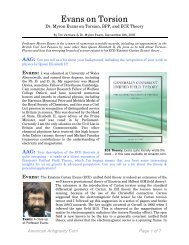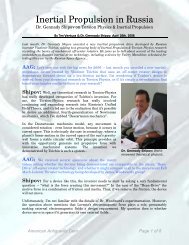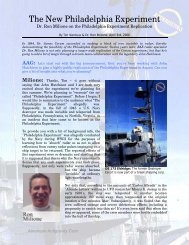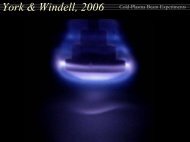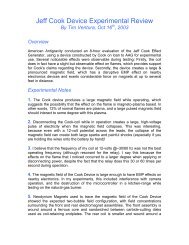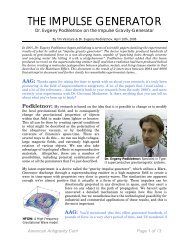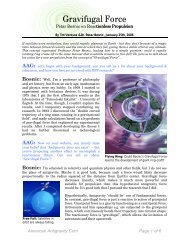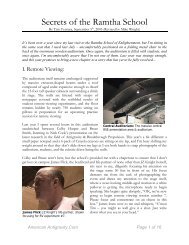Michael-McDonnough-I.. - American Antigravity
Michael-McDonnough-I.. - American Antigravity
Michael-McDonnough-I.. - American Antigravity
Create successful ePaper yourself
Turn your PDF publications into a flip-book with our unique Google optimized e-Paper software.
AMERICAN ANTIGRAVITY PAGE 1
By Tim Ventura &<strong>Michael</strong> <strong>McDonnough</strong>, May 5th, 2007<br />
Three years ago, Betavoltaic Industries was poised for success as a next-generation energy<br />
startup working past the bleeding edge and getting startling results. With products in<br />
development for both stimulated beta-decay nuclear batteries and a radical new vision for LENR<br />
fusion energy, Betavoltaic had it made, until it all went away. Meet <strong>Michael</strong> <strong>McDonnough</strong> –<br />
visionary, futurist, and former CEO, as we explore what went wrong and why it matters today…<br />
AAG: Betavoltaic is gone, but why? I’ve been following your work for 5 years now, and you’ve<br />
always been a leader in getting consistent results beyond the bleeding edge. When we did the<br />
interview back in ‘04, and you had it all: working fusion in the lab, and experimental results for<br />
stimulated beta-decay nuclear batteries. What went wrong?<br />
<strong>McDonnough</strong>: Business is all about timing –<br />
which in this case worked against us. I had the<br />
misfortune of starting Betavoltaic Industries shortly<br />
after September 11 th , and we were immediately<br />
hammered by a complete change in US laws and<br />
business practices, as well as a very dry technology<br />
investment climate that ensued following that event.<br />
Dr. Ruggero Santilli, our chief science director, was<br />
the first scientist I’d found who shared my vision of<br />
the neutron as the ultimate source of stored electric<br />
energy, in the form of beta-decay for certain isotopes.<br />
Santilli has since provided experimental evidence<br />
which supports this model, and he’s developed a new<br />
process capable of producing neutrons in the lab<br />
using only hydrogen and electrons. Not only does this<br />
neutron-synthesis technology work, but it produces a<br />
high enough neutron volume that Santilli’s had to<br />
evacuate his laboratory on several occasions.<br />
<strong>Michael</strong> <strong>McDonnough</strong>: Founder & CEO of<br />
the Betavoltaic Industries corporation.<br />
AMERICAN ANTIGRAVITY PAGE 2
In Santilli’s model, a neutron is a form of “compressed hydrogen atom”, so it makes sense that a<br />
technology could be built to “uncompress” the neutron back into hydrogen. This process of<br />
breaking the neutron into a paired proton and electron is referred to as an artificial stimulated<br />
beta decay of the neutron. If you can force the decay to occur with less input energy than you get<br />
back from the decay event itself, then you’ve opened to door to opportunities such as generating<br />
energy from nuclear waste, and maybe even harnessing energy by initiating stimulated decay in<br />
more stable isotopes with high beta decay energies such as Potassium 40 or Molybdenum 100.<br />
We obtained a funding agreement with Technology Capital and Markets (TCM) in Utah for<br />
$5,000,000, and in exchange, TCM took ownership of about 30% of the company’s outstanding<br />
shares. However, they never paid up, and after several years of being strung along with a series of<br />
small payments totaling less than $250,000, they unexpectedly pulled out after their primary<br />
investor died of a heart attack. We found out later the attack was caused by the shock of his<br />
discovery that TCM had been pocketing money<br />
earmarked for investment in Betavoltaic. For<br />
instance, on one occasion the investor had<br />
provided $350,000, and out of that sum $250,000<br />
was earmarked for Betavoltaic to pay for patent<br />
license fees and for proof of concept prototype<br />
development. We only obtained about $35,000<br />
from that payment - barely 10% of the amount<br />
we were supposed to have to build a prototype.<br />
We did what we could, using some of the funds<br />
to apply for a patent on stimulated decay<br />
technology, but it was rejected several times on<br />
technicalities and in the end we simply didn’t<br />
have enough capital to finish financing the<br />
application process. Patent attorneys charge<br />
about $200 per hour and with every pass back<br />
and forth to the patent office to Ruggero and the<br />
attorney we were paying thousands of dollars<br />
and received no indication that it would end<br />
without more costly rounds of revision. After<br />
spending over $10,000 on the patent application<br />
for stimulated decay we had to simply abandon<br />
the effort for a lack of funds and a lack of<br />
assurance that our payments would ever end in<br />
the award of a patent worth anything to the<br />
company.<br />
Betavoltaic: Schematics for stimulated beta-decay<br />
nuclear batteries capable of running for decades.<br />
Anyhow, that’s the short version of the story – after 4 years of struggle to obtain initial financing<br />
Betavoltaic Industries shut its books and called it quits. I still hold out hope to reform the company<br />
and try again someday when I’m financially secure enough to self-finance our efforts.<br />
AMERICAN ANTIGRAVITY PAGE 3
AAG: Now as I understand it, before Betavoltaic you were into advanced propulsion research –<br />
and in fact the need for reliable space-power systems became the initial motivation that led you<br />
into energy research, right? Obviously today’s systems just don’t cut it for producing the kind of<br />
electrical power you need for field-effect propulsion, so while you originally started out with a real<br />
interest in BPP, you found yourself working nonetheless on energy projects. How’d this all come<br />
about? Where does the story really first begin?<br />
<strong>McDonnough</strong>: I guess you could say the story begins with a number of UFO sightings that I’ve<br />
had over the years – after one particular encounter early on, I became intrigued by the flight<br />
characteristics that these craft display. I was living in Alaska at an Air Force Base at the time, and<br />
this unidentified craft passed overhead as if it was floating on a magnetic field. My vantage point<br />
was maybe a mile away from this craft but I could still feel an electric charge on my skin which<br />
seemed to emanate from its outer hull. After watching it for a while, the craft suddenly darted off<br />
out of sight – and right before it accelerated, I saw the bottom of the craft take on an orange<br />
plasma glow. This is of course ionized nitrogen for the most part. So this craft has a propulsion<br />
that had no exhaust, caused the craft to bob around like in a magnetic field, and ionized the air<br />
surrounding it enough to create a plasma. This was clear indication to me as a child to confirm that<br />
they used electric and magnetic fields for their propulsion. I was very interested in science and<br />
technology at that point and decided that when I grew up I was going to be a science and<br />
technology professional and look into what made these things fly.<br />
As you are aware Tim I started out in this venture by writing The UFO Technology Hackers Manual<br />
in the late 90’s. The book is all about solid state electric space propulsion, but one major drawback<br />
is the need for very high specific impulse<br />
which in turn leads to a requirement for<br />
very dense electric power production or<br />
storage. Nuclear technologies for<br />
spacecraft have been around for quite a<br />
long time but they’re not very safe for<br />
passengers, so I started researching energy<br />
technologies. After several years of study I<br />
found some alternative science theories<br />
that looked promising enough to meet the<br />
power-density requirements in manned<br />
space applications, but the lack of<br />
development in these energy technologies<br />
simply highlighted the need to form a<br />
company to pursue their development.<br />
The Manual: <strong>Michael</strong> <strong>McDonnough</strong>’s compilation of<br />
research on breakthrough propulsion technology.<br />
Everybody has to start somewhere, and for me, The UFO Technology Hackers Manual was a great<br />
place to start building exposure in the world of alternative-science. For a period of several years I<br />
sold it through my web site, and it generated enough buzz that it led to guest appearances on the<br />
Jeff Rense Show, The ParaNet Continuum, The X-Zone, and several other media venues. I was also<br />
featured in the 22nd edition of Atlantis Rising Magazine in an article by Jean Manning, and of<br />
course I’ve been covered on <strong>American</strong> <strong>Antigravity</strong> in a number of articles & interviews that have<br />
been very productive.<br />
AMERICAN ANTIGRAVITY PAGE 4
Even as my interests turned towards energy technologies, I continued doing BPP research on the<br />
side, but found after a few years that my efforts were no longer unique, and I decided to release<br />
the book as a free download. It’s been revised it to include some of my own experiences with UFO<br />
encounters, and I just recently re-released it as a bit-torrent file circulating in the P2P networks<br />
online. The P2P strategy is remarkably effective: in the 6 weeks that I’ve had it up as a bit-torrent,<br />
over 550 copies have been distributed online. Obviously it’s exciting to see this much exposure for<br />
it because it really is the product of a great deal of research. Of course, it’s also exciting to share<br />
the observations and ideas for applications for various patented technologies that I added in the<br />
revised version. Perhaps your readers can help me seed this torrent..?<br />
AAG: Now I’d like to ask about work with Betavoltaic technologies. You got me into this back in<br />
2002, and at the time there was a fair amount of research showing that an HV-capacitance could<br />
lead to a higher rate of nuclear decay; perhaps enough to turn a lump of rock into a battery. Can<br />
you help us with a bit of background on this?<br />
<strong>McDonnough</strong>: I vaguely remember you interviewing a person a few years ago making a<br />
nuclear battery in their garage or something like that. The concept is simple enough: applying a<br />
high-voltage to certain radioisotopes can cause stimulated Alpha-decay – and it’s a proven<br />
process. Several years ago, a company in the nuclear reactor service industry found this out by<br />
accident when some of their reactor fuel went missing. They immediately launched an<br />
investigation, and after they were sure that none of their employees had pilfered the materials,<br />
they found that the real culprit had been electric arc furnaces that were inadvertently converting<br />
some of the fuel into lighter elements – in this case, most of the missing fuel had simply been lost<br />
as helium. They did patent the technology but as of today I don’t think they’re pursuing it.<br />
Thus, it’s been known for a long time that particular elements will undergo a stimulated alphadecay<br />
and eject a proton under certain conditions: namely being positioned next to the negative<br />
pole in a high-voltage electrical field. Some elements create helium as they do this, with the<br />
remainder of the original atom being transmuted into a lower-isotope in the process. This is an<br />
interesting phenomenon, but unrelated to the stimulated beta-decay we were investigating.<br />
In yet another experiment, we found a form of photo-stimulated beta decay which occurs when<br />
the emitter is stimulated by a photon with a frequency close to the diameter of the interior area of<br />
the neutron. This photon’s peak is in the gamma spectra at about 1.292 MeV, and there’s a theory<br />
that other resonant peaks will be found in other areas of the spectrum. X-Rays are very likely to<br />
have a beta-decay stimulation frequency-peak as well as the UV spectrum -- although UV may be<br />
more useful for stimulating beta-decay in gaseous tritium, since it doesn’t have good penetration<br />
into denser isotopes. Unfortunately, most of the heavier elements that experience beta decay also<br />
produce a gamma or “bremsstrahlung” radiation, making them less than ideal for a betavoltaic<br />
battery.<br />
AAG: A number of people have done testing with stimulated beta-decay technologies: in addition<br />
to your work, I’ve seen others perform double-blind time-exposures on photographic plates, and<br />
AMERICAN ANTIGRAVITY PAGE 5
even seen a nuclear battery on an oscilloscope. Can you tell us about some of the experimental<br />
evidence you came across during your research, as well as your own experiments?<br />
<strong>McDonnough</strong>: We were working with Dr. Ruggero Santilli, who’s performed some key<br />
experiments demonstrating that neutrons can be synthesized by running a DC electric-arc through<br />
pressurized hydrogen. This validates Rutherford’s 20’s-era hypothesis that the neutron is a<br />
“compressed hydrogen atom”, as well as work on<br />
neutron synthesis in the 60’s by Italian physicist Don<br />
Borghi. These experiments have actually produced<br />
enough free neutrons that Santilli felt the need to<br />
evacuate his lab until the reaction cooled down, which is<br />
a surprisingly successful result.<br />
Santilli’s process is reversible: the stimulated decay of<br />
neutrons into paired electrons and protons is suitable for<br />
a wide-array of industrial applications, including the<br />
destruction of nuclear waste materials and generating<br />
power from long lived beta decaying isotopes like K-40<br />
and Mo-100. We did some experiments in these areas<br />
with the help of Santilli and others, but it’s beyond the<br />
scope of this interview, so let me direct your readers to<br />
further reading materials on Santilli’s website.<br />
Dr. Ruggero Santilli: Pioneer in Neutron<br />
Synthesis and a subatomic particle fusion.<br />
AAG: The last I’d heard of your betavoltaic project was a prototype you were working on back in<br />
2004. If I remember right, you had a mockup about the size of a cell-phone battery, right? What<br />
kind of performance were you predicting for it, and what kind of potential does the energy density<br />
in betavoltaics provide in general?<br />
<strong>McDonnough</strong>: The <strong>American</strong> public will never see commercial betavoltaic technology due to<br />
extreme intrusion into science and technology by the US Government. Unlike nearly every other<br />
nation in the world, in the United States you may not possess even the smallest quantity of an<br />
active isotope of any energy for use in a betavoltaic device. If you go into the UK, for instance, you<br />
will find a key chain available at the supermarket checkout which has a tritium and phosphorus<br />
light source -- this little marvel is illegal in the US. Another example is a common glowing paint<br />
that uses tiny glass bubbles coated with phosphorus and filled with tritium as a paint additive: it’s<br />
quite common for use on lighted exit signs in most countries but once again it’s illegal in the USA.<br />
These days a lot of people have complaints about the government’s meddling in people’s lives, but<br />
setting that aside, let’s simply state that you’ll never have the same technological freedom in<br />
America that citizens in the rest of the world take for granted. Our government is beholden to<br />
powerful monopolies that simply will not allow energy technologies of high density, high reliability<br />
and low cost to enter the commercial marketplace. Of course, this doesn’t apply to the military,<br />
who routinely uses this type of technology – but for you, me, and everyone else it’s off-limits.<br />
AMERICAN ANTIGRAVITY PAGE 6
In another country, where this technology might be tolerated, I’d tell you that betavoltaic<br />
technology is safe and reliable, that could recharge your cell phone for the life of the device. The<br />
estimated energy density using tritium is about 1 Watt per hour per cubic centimeter for 20 years,<br />
assuming ideal conditions and very efficient conversion technology.<br />
AAG: Next on the list is the Plasmavolt – a type of IEC fusion-in-a-bottle technology developed by<br />
inventor Arie DeGeus that you started testing in around 2004, right? You had some video for the<br />
Plasmavolt connected to an o-scope, and it was impressive to see the scope jump every time a<br />
flash occurred in the vortex-chamber. I guess what’s more impressive was the residue left after<br />
running this experiment for a few months – several grams of K 40 19, right?<br />
<strong>McDonnough</strong>: This is a touchy subject, since due to the failure of the funding company we<br />
were unable to complete licensing the technology from DeGeus. We invested over $140,000 in the<br />
Plasmavolt and saw some very promising test-results,<br />
but since we couldn’t complete the funding all of the<br />
technology rights reverted to DeGeus. It was a terrible<br />
waste of limited resources but we did feel the<br />
technology was promising.<br />
The inventor claimed that the device produced K 40 19, but<br />
we were never allowed to obtain a sample to submit for<br />
independent testing. He showed us some paperwork<br />
produced by a university spectrum analyzer which<br />
seemed to indicate a spike in the spectrum at the proper<br />
location for this isotope. We also posted some video of<br />
the device online, but DeGeus required us to remove it<br />
immediately.<br />
When everything’s said and done, this wasn’t a “proven<br />
technology” in the sense that it has ever produced<br />
commercial levels of power. However, it has been<br />
proven to produce output in excess of the input energy.<br />
This indicates that DeGeus’ concept of embedding lightmetal<br />
nuclei as a “fuel” in the device’s anode does<br />
generate energy in the form of low grade heat and light<br />
when it is decomposed by the hydrogen plasma.<br />
Remember from our interview back in 2003 that these<br />
light-metal nuclei eroding out of the anode and fusing as<br />
they spiral down through the reaction chamber is the<br />
key to the Plasmavolt design.<br />
There truly needs to be an independent analysis of the<br />
decomposition products generated by this device to look<br />
for the potassium isotope or any other products of<br />
transmutation – however, I just don’t see DARPA or any<br />
of the big labs rushing in at the last minute to save this<br />
The Plasmavolt: A tiny IEC fusion device<br />
in a bottle shown during lab testing in ’04.<br />
AMERICAN ANTIGRAVITY PAGE 7
project, because it’s just too obscure. After all, DARPA’s had well-known, world-class physicists like<br />
Robert Bussard working on their staff for years, and even his work couldn’t survive today’s tough<br />
funding climate for emerging science projects. It’s a shame, too, because in his case –just like the<br />
Plasmavolt– it all fell apart right when his team had achieved some really promising results.<br />
I think the best initial application for this plasma vortex fusion technology is in very high altitude<br />
research craft to generate heat for the electronics, power for a sterling cycle engine, and<br />
hydrogen gas for fuel. The reaction of the<br />
device’s anode is exothermic and very<br />
controllable, so I see this technology as<br />
being well suited for reliable heat<br />
production in a low oxygen environment.<br />
AAG: Obviously the next thing we should<br />
address is why you weren’t successful in<br />
bringing the Plasmavolt to market – it was<br />
investor-related, if I remember right. Care<br />
to talk about it, and what are your thoughts<br />
or opinions about anybody else pursuing<br />
commercial ventures, given your<br />
experience?<br />
Plasmavolt: A CAD rendering of the electromagnetic<br />
spiral vortex leading to IEC fusion in the Plasmavolt.<br />
<strong>McDonnough</strong>: We simply got taken by some venture capital people with poor moral<br />
character. They were shopping our business plan and private placement agreement around under<br />
the premise of seeking funding for us, but ultimate they were skimming the bulk of what they<br />
raised for themselves. This ruined us financially and permanently damaged our relationship with<br />
the inventors we were negotiating licenses with.<br />
Quite simply, if you want to get into alternative-energy, LENR, or any other type of safe alternative<br />
nuclear technology then you might want to look outside of the US, because our own country is<br />
completely dominated by the power monopolies. Energy start-ups will find a lot of money out<br />
there for wind farms and solar panel improvements but nothing for free energy, zero point energy,<br />
or any type of cold or warm fusion. You’ll get funding, but only if it doesn’t threaten the status quo.<br />
Speaking of threats, if you’re doing a startup you might also want to take out a big life insurance<br />
policy on yourself, your colleagues, and their families. I’d also suggest hiring full-time bodyguards,<br />
deploying technical surveillance countermeasures, and ultimately ensuring that your funding and<br />
intellectual property are protected from corporate and even government espionage. I’m not fearmongering,<br />
just being pragmatic, because you just can’t get into this business unless you capitalize<br />
on this technology in a very quiet way, and the best way to do that is with your own money.<br />
AAG: Now I want to switch gears a bit, because for the last couple of years you seem to have<br />
withdrawn from the online open-source community, which is a widespread trend. Why are<br />
innovators boiling out of the community, and what kind of changes did you make in life after your<br />
financing partnership fell apart?<br />
AMERICAN ANTIGRAVITY PAGE 8
<strong>McDonnough</strong>: Well, I’ve become a lot more careful in my dealings and I’m not making much<br />
money in the field so I’m not a target of interest at present. Let’s face it: the open-source<br />
community has proven in several instances that it attracts the attention of the wrong people – the<br />
development of the Joe Cell is but one example.<br />
Open-sourcing sounds like a great idea until the practical limitations are discovered. If someone<br />
shows success in his or her experiments they run the risk of black-ops goons paying them a visit.<br />
Reports of this have a very chilling effect on the community. Also, commercial interests monitor<br />
the community and are very likely to patent the work of the open source community due to a<br />
naïve lack of awareness that being open-source is not much protection when you have no money<br />
for a legal defense of your work product.<br />
AAG: Do you still believe in the open-source concepts that drove the newsgroups and early<br />
community-building efforts? I mean, 4 years ago you put a lot of energy into a free PhP Content<br />
Management System for alt-science webmasters, and the trend continues with open-source<br />
contributions like the bit-torrent download for your book. Is that ideal still alive, has it changed or<br />
evolved over time?<br />
<strong>McDonnough</strong>: The concept of open-sourcing interests me, but I can’t say in good conscience<br />
that I share many of my current projects with the community. From an investment standpoint, it’s<br />
impractical to just give away the product of my time and<br />
labor in an unprotected manner online. It’s something<br />
that people do when they’re competing for mindshare,<br />
not when they’re working towards commercially viable<br />
products.<br />
On the other hand, releasing my book as a bit-torrent is<br />
an example of taking information that already exists in<br />
the public domain and condensing it for use by other<br />
like-minded researchers. I’ve also uploaded some<br />
interesting experiments to YouTube under the username<br />
vortexentity. Those are areas where I can contribute and<br />
help others without jeopardizing my own livelihood in<br />
the process.<br />
Free Energy: A YouTube video clip by<br />
<strong>McDonnough</strong> for open-source researchers.<br />
AAG: I get the impression that your projects today are much more down to Earth than the fusion<br />
& stimulated-decay projects that came before. One that comes to mind was a biomass-conversion<br />
project to produce fuel from yard waste, if I remember correctly. Can you tell me a bit about that<br />
project, and what drove you from bleeding-edge nuclear engineering to much more conventional<br />
technologies?<br />
<strong>McDonnough</strong>: I’m interested in the technologies of Dr. Ruggero Santilli. The waste to energy<br />
technology he has developed and many have tried to copy is the best in its class for converting<br />
AMERICAN ANTIGRAVITY PAGE 9
waste liquids into fuel for transportation. Ruggero and I have remained good friends over the years<br />
and his intellect and honesty has been an inspiration for me.<br />
Their MagneGas technology that Santilli has developed is proven to produce viable, non-polluting<br />
fuel that can be made from almost any liquid waste. It’s now far cheaper and smarter to obtain our<br />
transportation fuels form this underwater-arc technology than from hostile foreign nations.<br />
MagneGas can be mixed in any quantity with Liquid Petroleum (Propane) or Natural Gas and it<br />
improves the combustion characteristics of those fuels. It can also be standalone solution that<br />
provides even better results, and it can run in any internal combustion engine that you’d normally<br />
convert to LP or Natural Gas. After all, MagneGas is far<br />
cheaper to make than hydrogen and has better<br />
performance in engines than ordinary hydrogen – why<br />
not use it as a standalone fuel?<br />
Ruggero’s company is about to go public, and I<br />
understand that when they do we’ll be seeing a version<br />
of this technology for the home market. You’ll be able to<br />
lease a small device from them no larger than a<br />
residential air-conditioner that will produce enough fuel<br />
for your personal transportation needs at far less than it<br />
costs to buy gasoline at the pump.<br />
MagneGas: A demonstration vehicle<br />
converted to run on Santilli’s MagneGas.<br />
I’ve also been working on a project to convert waste-biomass to fuel, but unfortunately it has also<br />
folded. The goal was to establish a residential service to convert yard-waste into a synthetic gas<br />
that could have been used for energy production in the hot summer months when yard waste is<br />
produced. Unfortunately, it fell through due to a lack of funds.<br />
AAG: On that note, since we’re talking about biomass, I should really ask about biomass and the<br />
President’s latest “State of the Union” address, in which he talked about using fuels from corn &<br />
switchgrass as a means of becoming energy independent. What are your thoughts on this trend –<br />
both in the public & private sector? Is it being executed well, and can it be done better?<br />
<strong>McDonnough</strong>: I’ve observed that the government typically only gets involved in a technology<br />
sector to reduce or eliminate market competition by awarding exclusive rights to key political<br />
contributors. I think the real reason for Bush’s sudden interest in becoming green is motivated by<br />
whatever he plans to do once he’s out of office. After all, his family just purchased a 100,000-<br />
hectare plantation in Paraguay that will likely be producing crops for biofuels in the near future.<br />
Call me a cynic, but I think his only motivations are money and power for himself and his friends.<br />
AAG: Right now you’re working on a few different projects, including one with a company called<br />
“Qbit”, as well as a concept for harvesting sea-grown algae and cracking them to produce<br />
petroleum. What can you tell me about this, without getting too proprietary? Why bother with<br />
algae when the administration is pushing corn?<br />
AMERICAN ANTIGRAVITY PAGE 10
<strong>McDonnough</strong>: This coves a number of unrelated projects that I’m working on, so let me start<br />
with producing bio-fuels from algae first. I’ve obtained the site http://www.algae-biodiesel.com<br />
and plan to develop this into an information resource and ultimately a company for producing<br />
algae-biodiesel.<br />
The administration’s push for corn-based biofuel will be a short-lived, because the world’s poor<br />
will push back - the market won’t allow the use of so much arable land for production of crops for<br />
fuel when people need to eat.<br />
On the other hand, using algae to produce biofuel is a completely different story, and benefits from<br />
completely different economics. Algae have a nearly identical chemical profile to sweet crude oil.<br />
Also, algae can be produced with gray-water that isn’t suited for crops, and on land with soil that<br />
isn’t suited for farming. As much as 60% of the dry weight of certain algae species are composed<br />
of fatty acids suitable for conversion into bio-diesel, and it doesn’t require fertilizers, insecticides,<br />
or much fuel to grow or process - corn requires a great deal of all of these things.<br />
In fact, it doesn’t take long to realize that corn isn’t really that “green” after all. Much of the corn<br />
proposed for fuel will be the BT variety which is indicated as producing pollen that harms honey<br />
bees when they ingest it for food. This could end up wiping out the honey bees that we depend on<br />
them for our own survival – and as you’re already aware, bee colonies all over the United States<br />
are already in trouble from other causes. Corn based biofuel just isn’t a wise choice for fuel, and it<br />
will ultimately be pushed aside as more sane and intelligent methods are put forward such as<br />
algae based biofuel.<br />
AAG: River-runoff from pig-farming in the Southern US is blamed for causing algae blooms that<br />
are currently causing major fishkills by deoxygenating the water. Could this concept for creating<br />
petroleum from algae actually be used as a form of environmental cleanup, as well?<br />
One of the directors on Betavoltaic’s corporate board has been involved in the design of<br />
aquaculture systems to clean up pig waste using algae, but they didn’t attempt converting the<br />
algae into fuel. He’s provided me with some mentoring in this area and I’m working on<br />
environmental proposals to cleanup river pollution using similar systems. I see algae farming as<br />
best used to treat the major source of pollution.<br />
For instance, an excellent example is the treated waste-water connection in sewage treatment<br />
plants. Even though the water is treated enough to be released into the river, it is still very high in<br />
nutrients that algae love, like nitrogen and phosphorus. If an intensive algae farm is positioned<br />
where this waste-water enters the river, not only will fuel-algae grow successfully, but the river<br />
water will be filtered enough that wild algae won’t grown from the treated waste water. Thus,<br />
producing biofuel can also be a means to save our very damaged domestic coral reefs.<br />
AAG: Is Qbit the same company that’s also pursuing the notion of creating an Island in the<br />
Caribbean? If I remember right, it’s off the Coast of South America, where they want to build up<br />
land in the shallow water to actually create new property, and then new laws to foster innovation<br />
as well. How’s that project going?<br />
AMERICAN ANTIGRAVITY PAGE 11
<strong>McDonnough</strong>: Qbit has an interest in the Principality of New Utopia, which is a budding<br />
nation-state located on the Misteriosa bank in the Caribbean. Qbit owns a very large area they<br />
intend to develop at some point. I also have land<br />
and title from the Principality and plan to<br />
develop my area in the near future. The average<br />
depth is about 65’ and the water is completely<br />
clear. I was also involved in obtaining permanent<br />
legal protecting for most productive coral reef<br />
area on Misteriosa Bank, which will be protected<br />
from development forever.<br />
New Utopia’s laws are based on the principle of<br />
“doing as you will so long as you harm no other”.<br />
We also feel that if you commit to something<br />
you should see it through to completion. Other<br />
than this, all citizens of PNU are free to develop<br />
themselves and their businesses as they see fit.<br />
The government of New Utopia is based on<br />
libertarian principles, and will not produce or<br />
protect corporate monopolies that stifle<br />
competition. Other than organizing defense and<br />
police, the government pretty much stays out of<br />
the way and allows all citizens to keep their<br />
wealth to themselves. We abhor communism<br />
and socialism in all forms and have a capitalistic<br />
outlook that empowers individual success based<br />
on hard work and innovation.<br />
New Utopia: Schematics for the libertarian flotilla<br />
nation-state on the Misteriso Bank in the Caribbean<br />
AAG: You briefly mentioned some really advanced projects - anything you can tell me about<br />
these? Based on our discussion so far, I’m almost afraid to ask…<br />
<strong>McDonnough</strong>: I’m under a non-disclosure with Qbit, but the CEO has indicated that I can speak<br />
in generalities about some of Qbit’s advanced projects. One of those is a development project for a<br />
type of nano-fusion technology they’re calling “Micro-Nova”. I’m working to obtain a development<br />
contract for this technology and it looks like we’re going to get it. The Micro-Nova technology is<br />
unlike any other single method of fusion because it incorporates several means for producing Low<br />
Energy Nuclear Reactions (LENR). It uses water as its primary fuel, and if it’s as successful as the<br />
models indicate then I think we’ll end up with a reactor that’s not much larger than a football and<br />
but can power an electric spacecraft. The propulsion technology for this craft is also on the<br />
drawing boards at Qbit.<br />
The other technology I’ll likely be involved with developing is a device that produces alterations in<br />
the probability that a given event will take place. Think about that last line for a few seconds to let<br />
AMERICAN ANTIGRAVITY PAGE 12
it sink in…this is big idea stuff. Basically, it’s a quantum control system that increases the<br />
probability of an event happening. The primary commercial application for this is an electronic<br />
trading system that can alter the likelihood of a given commodity or derivative increasing or<br />
decreasing in value, which gives new meaning to the phrase “gaming the market”.<br />
AAG: I’d like to wrap things up by asking about your future plans. What’s next for <strong>Michael</strong><br />
<strong>McDonnough</strong>, and when can we expect to see it? Also, let’s find out about web-addresses for what<br />
you have online, and maybe some contact info for the audience if possible?<br />
<strong>McDonnough</strong>: I plan to continue researching<br />
the latest advanced technologies and positioning<br />
myself to work on the most promising<br />
applications. I also will continue in my efforts to<br />
produce floating communities in the Caribbean<br />
and elsewhere. I’m convinced that these floating<br />
enclaves will be a resource for creativity and<br />
wealth that will help everyone in the long run<br />
because they’ll facilitate the development of<br />
technologies that would threaten monopolies in<br />
the established power-structures of nations like<br />
the United States.<br />
I’ve signed into an agreement with a company<br />
for the development of this floating city concept<br />
for the Middle East region as well. They hope to<br />
Changing Probabilities: <strong>McDonnough</strong>’s current<br />
projects include a device to influence probabilities.<br />
move the US military completely off of their land and out into secure floating cities in the Persian<br />
Gulf – and I’ll be helping to design those structures. This also dovetails into a proposal I’m finishing<br />
up for floating algae biodiesel factory farms that can be positioned in any suitable waste stream.<br />
I enjoy working with small companies with outstanding potential like Qbit to develop their<br />
promising technologies, and I will likely be working with MagneGas on the marketing of their<br />
home-based waste-to-energy technology once they take the company public. Finally, I’ll continue<br />
to work towards producing space transportation systems that are affordable for the consumer,<br />
which I think brings this interview nearly full-circle.<br />
My web contacts are as follows: We still have betavoltaic.com, and my book is available as a free<br />
download. There’s also the New Utopia Flotilla site, and I have a gallery of computer artwork on<br />
display at the CG Society site online. As I mentioned earlier, there are also video-clips that I’ve<br />
published on YouTube under the username vortexentity. Other than this, there are probably a few<br />
additional URL’s that I’ve neglected to list, but your readers can email me for them or to learn<br />
more about my current projects.<br />
<strong>Michael</strong> <strong>McDonnough</strong> is the former CEO of Betavoltaic Industries, author of “The UFO Hacker’s<br />
Manual” and a well-known new-energy activist and researcher in the Florida area. His current<br />
projects include work with the New Utopia Flotilla Corporation and the Qbit Corporation. For<br />
additional information, contact him via email at tech1@tech-utopia.biz.<br />
AMERICAN ANTIGRAVITY PAGE 13



